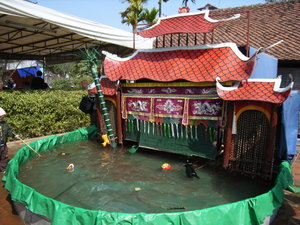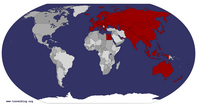Advertisement
Published: February 6th 2009

 Museum of Ethnology
Museum of Ethnology
Along with water puppet shows at the Museum, a mini theater was also set up, so that children could learn how to control the water puppets.Hanoi, Friday 30 January 2009 - the 5th day of the lunar New Year - Tết 2009, the Year of the Buffalo. Myself, sister and her friends rented a taxi and we went to the Museum of Ethnology. From 29 January to 1 February there were many activities and traditional games at the Museum for celebrating the lunar New Year. They were performed by Vietnamese and ethnic minority people who came from other provinces in Vietnam. Some activities and games were bamboo-stick dancing (the Thai), swinging (the Viet), tug of war (the Viet), Đông Hồ woodblock paintings (the Viet), water puppetry (the Viet), playing "còn" ritual balls (the Thai), making clay cracker and buffalo shaped toys (the Viet), dancing and love-exchange singing (the Hani, Lu and Cong), pan-pipe, leaf-horn, jew's harp playing (the H'mong) etc.
We spent much time at the area where the Đông Hồ woodblock paintings (see my photos 15 - 23) were made. This is the most famous traditional painting style in northern Vietnam which experienced 300-year history. The paintings are drawn on "Dó" (poonah) paper with coloring from pigments in half-baked bricks, tree leaves, ground coal, roots and resin. They reflect the aspirations of the people

 Museum of Ethnology
Museum of Ethnology
These Lư ethnic minority women come from Lai Châu province in northern Vietnam. They are sitting by the houses of the Hani at the Museum. A girl is explaining the difference of scarfs on their heads between the married and single women.for peace, prosperity and happiness. The famous place for making these paintings is Đông Hồ village, Bắc Ninh province in northern Vietnam. This year, some artists from this village also participated in the spring festival at the Museum for introducing this form of arts, so we had the chance to see the painting process.
First, we bought papers (VND 6,000 per piece, about 30 US cents) and brought them to the artists for painting (free of charge). Each artist was in charge of a part of the paintings and they used wooden moulds. Some traditional paintings they introduced this time were the buffalo fighting (chọi trâu), chicken family (gà đàn), pig family (lợn đàn), little girl holds a duck (em bé gái ôm vịt), and little boy with flute on a buffalo (em bé chăn trâu thổi sáo). After the paintings were complete, we dried them in the sun.
At 2:30pm, there was a water puppet show at the outdoor theater of the Museum, but we decided to leave before that and moved on to the citadel (Hoàng thành Thăng Long). At that time, a God worshiping ceremony (Lễ tế thần) was being held. The offerings were sticky

 Museum of Ethnology
Museum of Ethnology
Banners and flags for advertizing the Spring Festival.rice and heads of pig and chicken. The boys and girls wore traditional clothes and performing ritual procedures.
Inside the Temple of Literature (Văn Miếu), the human chess game (cờ người) was played, but I didn't visit the place. The street of calligraphy artists (Phố ông đồ) outside the temple was a new attraction in Hanoi this year. There were also many activities by Hoàn Kiếm lake in Hanoi's center. A musical stage was set up and traditional folks were performed there since the New Year's eve.
The photos in this blog were taken on 30 January 2009 and arranged in order of the Museum of Ethnology, the citadel (Hoàng thành Thăng Long), Hoàn Kiếm lake and the calligraphy artists on Văn Miếu street. The final photos were taken on 4 March 2009 at the festival in Sài Đồng village of Hanoi.
Festival in Sài Đồng village (4 March 2009)
Photos No. 42 to 44 - While traveling on the National Highway No. 5 towards Bắc Ninh province for visiting Phù Lãng ceramic village, I passed by Sài Đồng village and heard the music, so I guessed there was a festival. I asked the driver

 Museum of Ethnology
Museum of Ethnology
I am standing at grassplot near the houses of the Hani ethnic minority group (dân tộc Hà Nhì) in northern Vietnam.to stop the car and walked towards the crowd in order to take photos.
I walked along the road with trees lining both sides and festival flags of 5 colors (cờ ngũ sắc), through a market and joined the crowd sitting on the bank. A boat appeared and came towards us. There were singers on the boat and they were singing traditional folk songs. Sometimes the audience sitting on the bank wanted to tip the singers. The boat sailed up close to the bank and a woman held out a flat hat to receive the tips.
The type of songs these singers performed is known as "Quan họ" from Bắc Ninh province. The organizers of the village temple festival (hội đình làng Sài Đồng) invited them to participate in the event. According to a Vietnam Tourism website, "Quan họ" singing is a folk art of a highly collective nature. During village festivals, which are held every year, particularly in spring, young men and women gather in the yard of a communal house or pagoda, on a hill or in a rowing boat, and sing "Quan họ". This is a style of singing where songs alternate from group to

 Bách ngệ khôi hài (Việt)
Bách ngệ khôi hài (Việt)
At the Ede long house in the Museum, a show called "Bách ngệ khôi hài" is performed. It means "singing and dancing to describe the 4 main jobs in Vietnamese traditional society" (the Viet).group.
In another blog, you've seen many photos of my Vietnamese traditional dresses for women. Some photos in this blog show you other types of traditional dresses for North Vietnamese people. The men also wear traditional dresses with small turbans, however their dresses are loose, not so tight like those worn by women. The women standing in front and at the rear of the boat wear traditional dresses of "Quan họ" singers in Bắc Ninh province. The women standing in the middle, as well as the boat rower, wear other types of traditional dresses.
Hội vui xuân Tết Kỷ Sửu 2009 tại Bảo tàng Dân tộc học Hội vui xuân năm nay giới thiệu các điệu múa, điệu hát, các loại hình trình diễn, các trò chơi dân gian gắn với tín ngưỡng phồn thực trong các lễ hội dân gian của một số dân tộc ở Việt Nam.
Trình diễn nghệ thuật dân gian:
- Hội trình nghề tứ dân chi nghiệp hay còn gọi là "Bách nghệ khôi hài" (phần hội trong Lễ hội Trò Trám - một lễ hội dân gian độc đáo mang đậm tín ngưỡng phồn thực của
người Việt). Đây là lần đầu tiên những vai diễn, những lời hát vui nhộn, mang tính hài hước về các nghề khác nhau trong xã hội được những người dân đến từ xóm Cổ Lãm, xã Tứ Xã, huyện Lâm Thao, tỉnh Phú Thọ đem đến trình diễn tại Bảo tàng.
- Múa rối nước dân gian của phường rối nước Hồng Phong, huyện Ninh Giang, tỉnh Hải Dương với các tích trò độc đáo vui nhộn.
- Múa xoè, múa sạp của người Thái.
- Múa khèn, thổi kèn lá, đàn môi của người Hmông đến từ huyện Mù Căng Chải, tỉnh Yên Bái.
- Thư pháp của người Việt.
- In tranh Đông Hồ, làng Đông Hồ, huyện Thuận Thành, tỉnh Bắc Ninh.
- Múa, hát giao duyên (Hà Nhì, Lư, Cống).
Chơi và thi các trò chơi dân gian: pháo đất, đánh đu, kéo co, đẩy lưng, đẩy gậy, chọi trâu (Việt); Ném còn, tó má lẹ, én cáy (Thái); Ném pao, đánh cầu lông gà, đánh cù (H'mong).
Khách tham quan cũng được hướng dẫn làm một số sản phẩm hình con trâu như mặt nạ trâu,

 Outdoor water puppet theater
Outdoor water puppet theater
The puppeteers stand behind the curtain and control the puppets with poles and strings. Water puppetry is a famous form of arts in Vietnam. This theater is located at the Museum of Ethnology. In the center of Hanoi, there is a large indoor Water Puppet Theater.trâu đất nặn, trâu bằng bột, tranh cát hình trâu, nghé ọ bằng lá đa, in tranh dân gian hình trâu, học cách làm quả còn Tày, Thái.
Lễ hội tại làng Sài Đồng - Ngày 4/3/2009 Khi đang đi trên đường Quốc lộ số 5 về hướng Bắc Ninh để đến thăm làng gốm Phù Lãng, tôi đi ngang qua làng Sài Đồng và nghe thấy tiếng hát quan họ phát ra từ phía đó. Tôi liền chạy qua đường và đi qua chợ về hướng đình làng. Trên hồ nước là chiếc thuyền rồng và các nghệ sĩ đang biểu diễn hát quan họ (ảnh 42 - 44). Cô gái đứng ở đầu mũi thuyền chìa chiếc nón quai thao mỗi khi có khách muốn đưa tiền tip. Đây là lần đầu tiên tôi được xem hát quan họ biểu diễn trên hồ nước, giống như ở Hội Lim.
Advertisement
Tot: 0.146s; Tpl: 0.016s; cc: 15; qc: 36; dbt: 0.045s; 1; m:domysql w:travelblog (10.17.0.13); sld: 1;
; mem: 1.2mb





























Graciela
non-member comment
My next trip
I love your blogs, they are very interesting. I will be there next October or November, before the high season. We will be in contact. Love from Argentina.